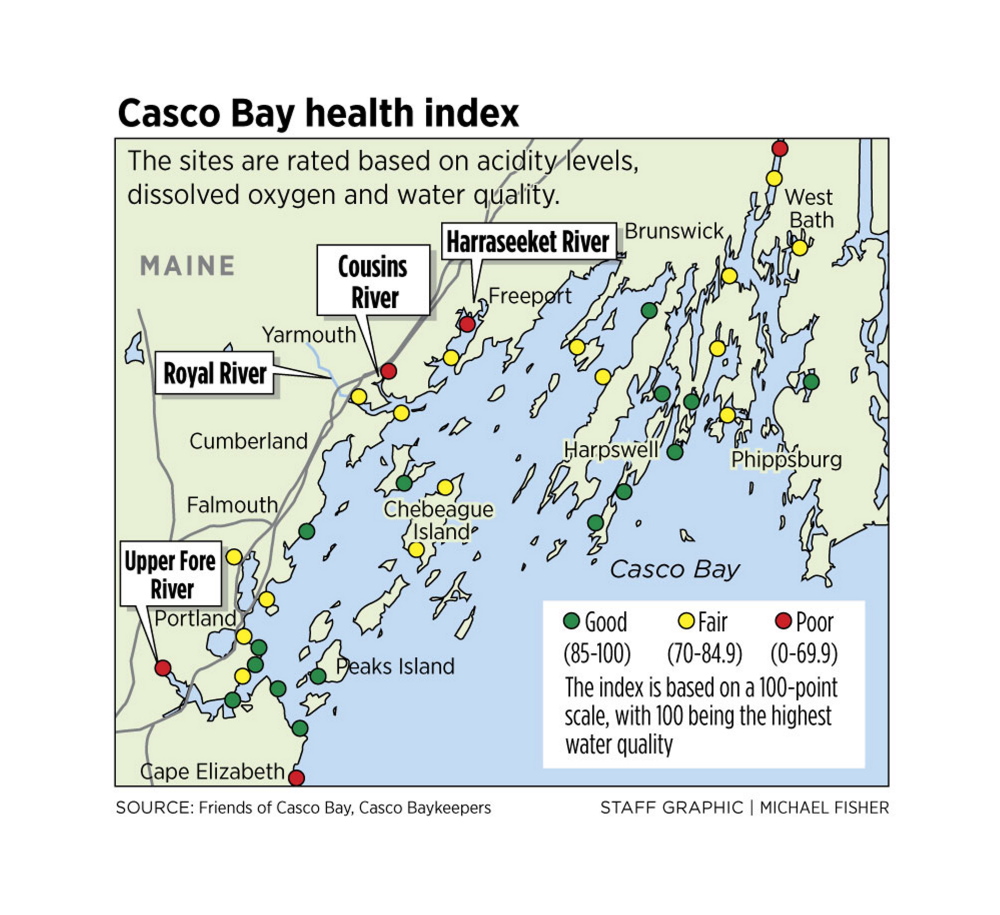Casco Bay is healthy, but water quality near coastal areas and estuaries is rapidly degrading because of man-made pollution, according to a study released Tuesday by the Friends of Casco Bay.
The report containing more than 10 years of data collected between Cape Elizabeth and Cape Small shows that the effects of global climate change and the local introduction of nitrogen and other pollutants have significantly altered the chemistry of Casco Bay’s waters.
The most pressing problem is the acidification of mud flats and coastal waters, a process that has led to reduced stocks of clams, mussels and other sea life, threatening the balance of a treasured resource, the report said.
“Overall the bay is good, but there are challenges,” said Cathy Ramsdell, executive director of the Friends of Casco Bay. “About 60 percent of the sites we study were only fair or poor in quality.”
With the help of about 100 certified volunteers, Friends of Casco Bay monitors 40 sites. The water at each location is sampled 20 times a year and tested for clarity, acidity, dissolved oxygen levels and other characteristics.
Together, the data give a portrait of life under the surface – where it thrives, and where it doesn’t.
The watershed that drains into Casco Bay encompasses the most populated and developed part of the state, home to about 250,000 people and covering nearly 1,000 square miles.
The worst conditions are found closest to shore or in the mouths of the various rivers that empty into the bay. Those spots include Peabbles Cove in Cape Elizabeth, the Upper Fore River in Portland, the Cousins River in Yarmouth, the Harraseeket River in Freeport and the New Meadows River near West Bath.
Peabbles Cove, which is the only non-river with the lowest rating, suffers from extraordinarily high plant growth, fueling a cycle of oxygenation followed by deoxygenation that does not stop.
Data show that the water quality improves as the distance from the shore increases, according to the report.
Places where the ecosystem looked the healthiest were found on Peak’s Island, around South Portland and Scarborough, and in the Harpswell and Phippsburg areas.
THE EFFECTS OF TOO MUCH NITROGEN
The geographic distribution of healthy areas and trouble spots makes sense, said Mike Doan, a researcher with the group, because of the trend of populated areas being most responsible for producing nitrate-rich runoff.
Nitrogen in Casco Bay comes from three main sources: human sewage, the atmosphere, and fertilizer spread on lawns and gardens that runs off into storm drains emptying into the bay.
While nitrogen is a required building block of life, stimulating growth of plant material on land and in the ocean, too much of it can spur out-of-control growth of algae in coastal waters. When the algae dies, bacteria that break down the dead plant life use the oxygen in the water, degrading its quality without a reciprocal process to add oxygen back to the ecosystem.
The dead material also contributes to murkiness, which prevents sunlight from penetrating into deeper water where it could reach more plant life.
These factors play into a “double whammy” for Casco Bay, the report said. Not only is the bay being harmed by artificially increased nitrogen levels, it also is showing the effects of globally occurring ocean acidification caused by carbon dioxide from the atmosphere, which has reduced ocean pH levels over the past 200 years.
DEGRADING THE SEAFOOD ECOSYSTEM
This trend is visible in Casco Bay, where the pH level has trended downward over the past 13 years.
“As the system becomes more acidic, it becomes harder and harder for organisms to grow,” Doan said.
In clams, for instance, the acidic water eats away at shells, releasing the clam’s calcium-rich casing into the water.
Rick Granz and his wife, Jennifer Fox, who have owned and operated Andy’s Old Port Pub for eight years, said they see Casco Bay’s changes during their daily trips to and from their home on Great Diamond Island.
After significant rainstorms, like those last week, Casco Bay turns the color of coffee – clouded by freshwater contaminated with fertilizers, dog waste and silt, Granz said.
Although there are fewer pipes releasing raw sewage into the bay than there were three or four decades ago, there are more people living on the coast now, he said.
Granz sees the threats to the bay also affecting the larger ecosystem and the seafood that Mainers take for granted.
At their restaurant and pub, Maine-caught seafood is harder to come by, Fox said. Particularly hard-hit have been haddock and shrimp, she said.
“The Maine foods that we’re proud to serve are not available to us anymore,” she said.
Send questions/comments to the editors.




Success. Please wait for the page to reload. If the page does not reload within 5 seconds, please refresh the page.
Enter your email and password to access comments.
Hi, to comment on stories you must . This profile is in addition to your subscription and website login.
Already have a commenting profile? .
Invalid username/password.
Please check your email to confirm and complete your registration.
Only subscribers are eligible to post comments. Please subscribe or login first for digital access. Here’s why.
Use the form below to reset your password. When you've submitted your account email, we will send an email with a reset code.